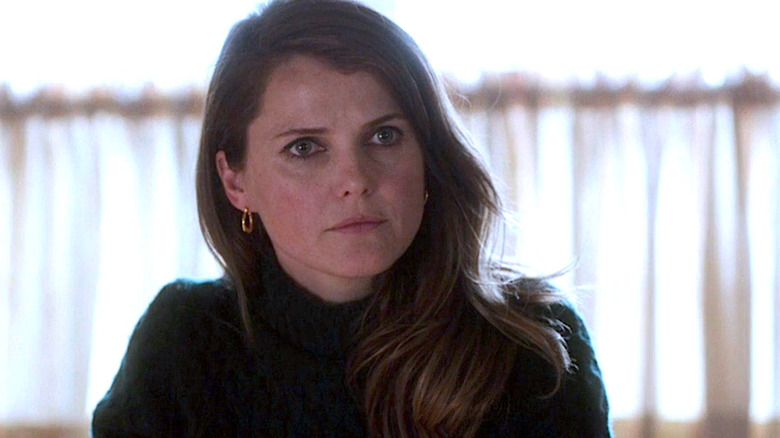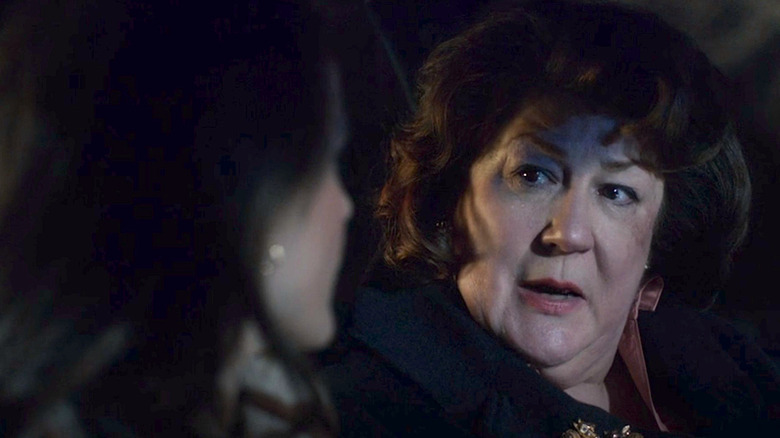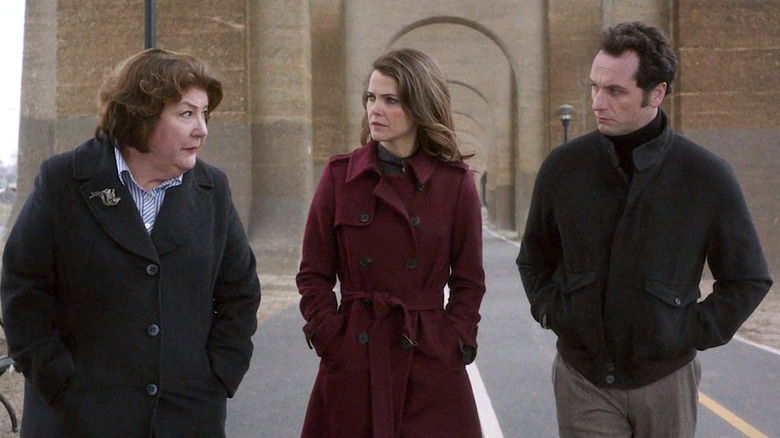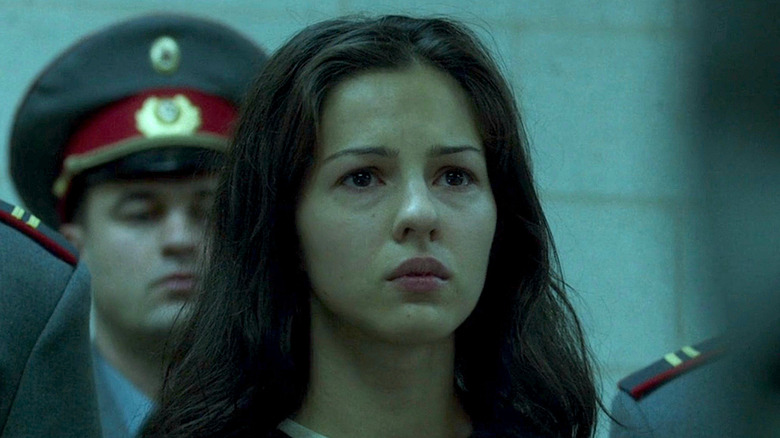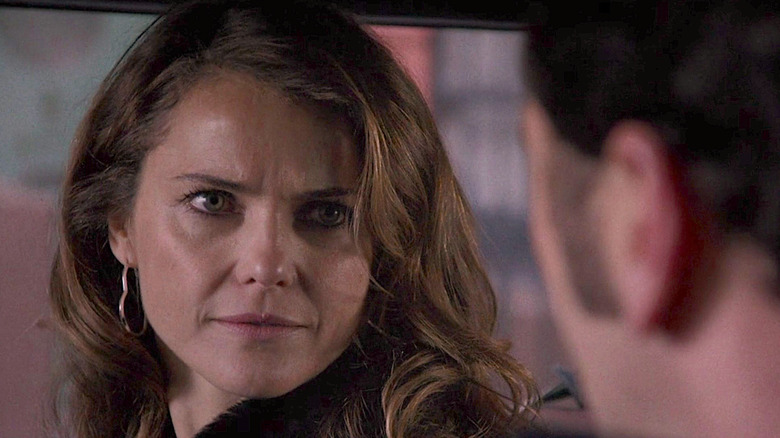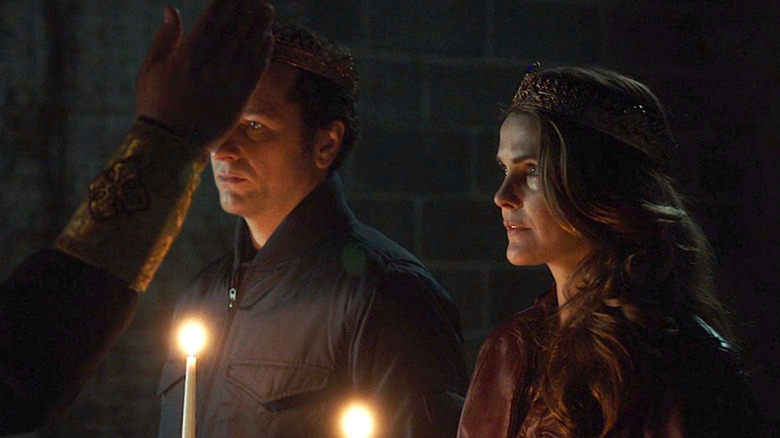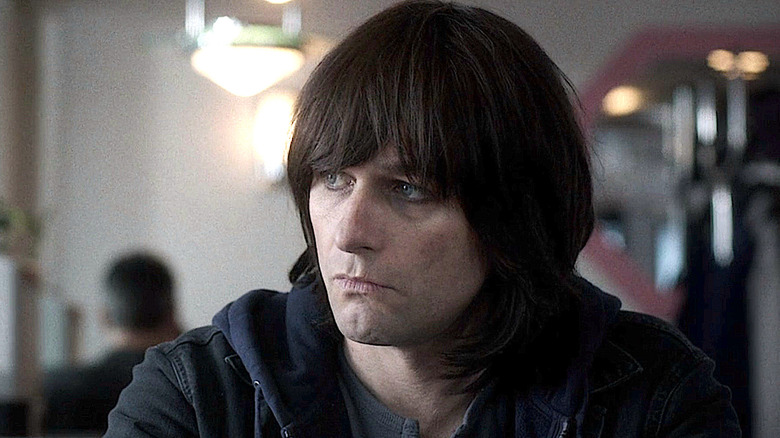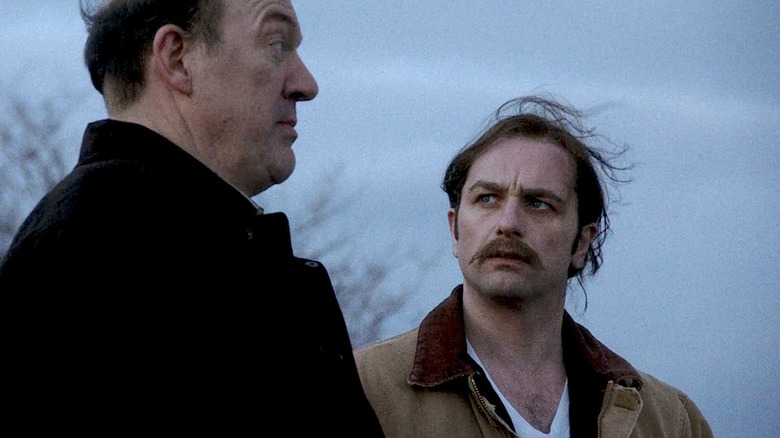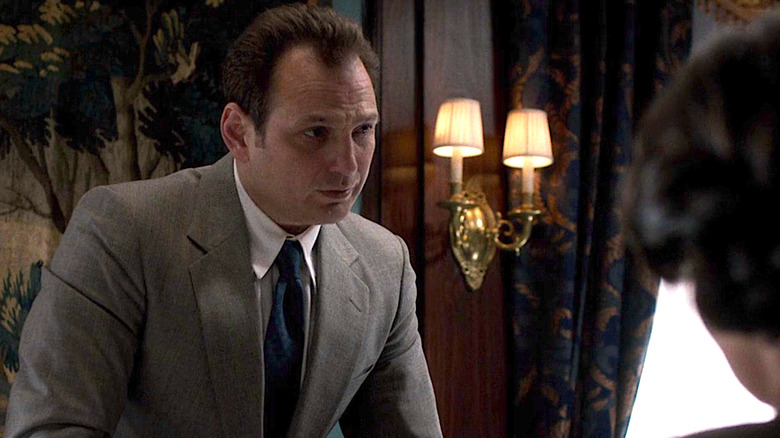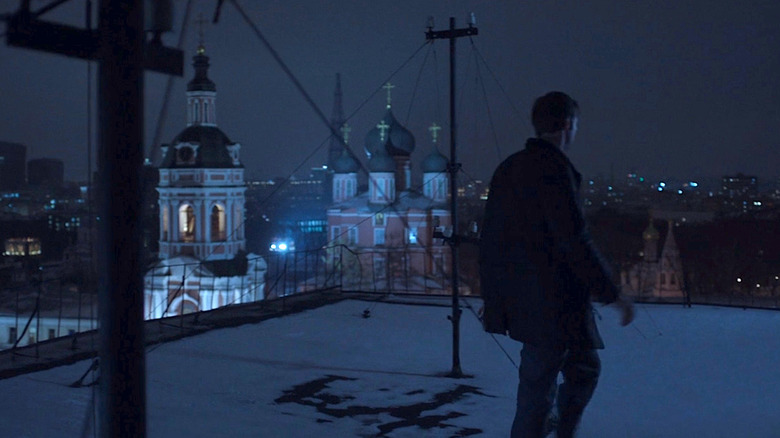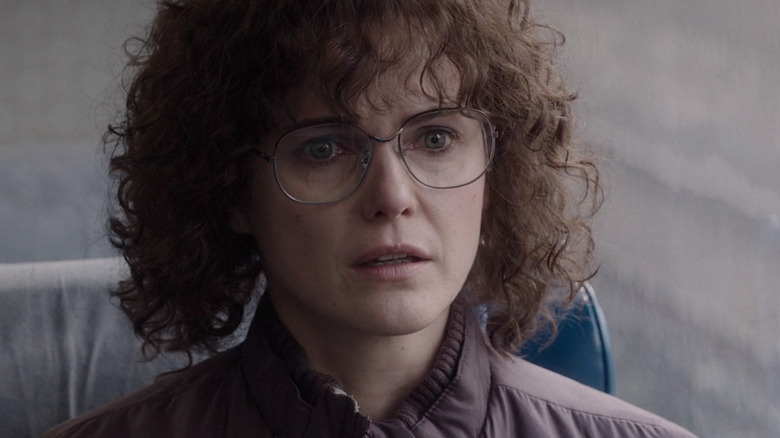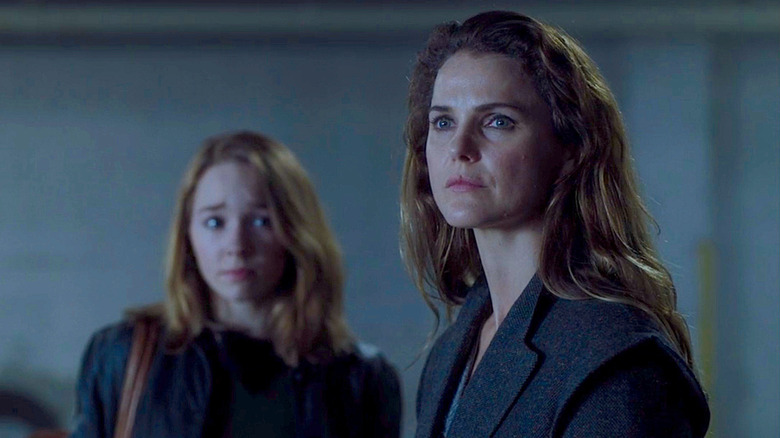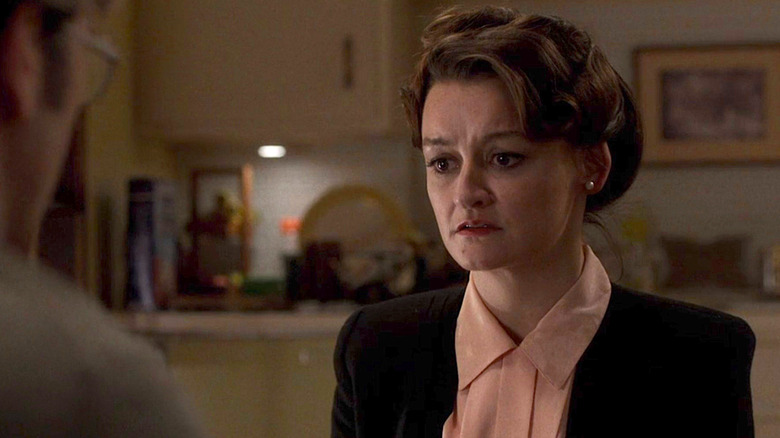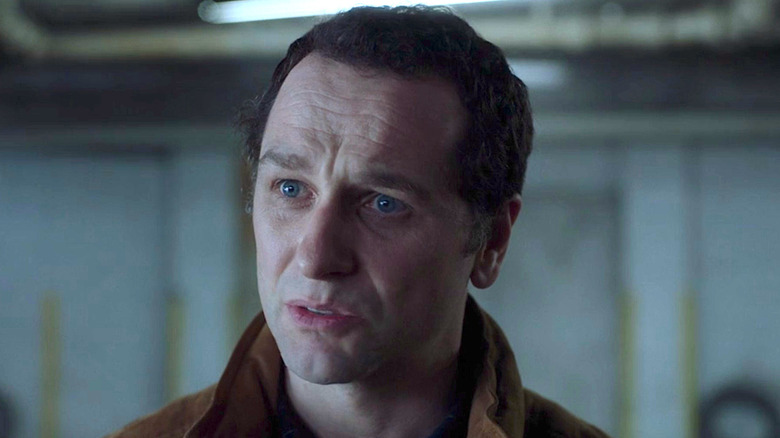Spy These 13 Facts About The Americans Only Major Fans Will Know
Marriage isn't for the faint of heart — and neither is being a KGB agent with a travel agency and kids in 1980s America. "The Americans" is a TV show unlike any other, about what it means to be married, to be the enemy, and to be in disguise. It's also about the constant search for identity, purpose, and family in a world seemingly built to destroy all three in service of a single ideology.
"The Americans" is the work of co-showrunners Joe Weisberg and Joel Fields. It stars Keri Russell and Matthew Rhys as Elizabeth and Philip Jennings, a pair of Soviet spies constantly testing what it means to be married to each other — and to a cause. The six seasons of the show chart their marriage as it shifts from one of duty to a genuine partnership infused with romantic love.
The show is anything but a typical spy series, even though it features a stomach-churning amount of down-and-dirty spycraft, along with a heaping helping of fabulous wigs. Avid viewers already know "The Americans" is a work of stunning devastation, sexy tooth-pulling scenes, and the surprising drive to survive, no matter the cost. While it may be some time before you spent hours watching the Jennings blaze their deceptive trail through the D.C. area, make sure your spoiler-antidote is nearby as we lead you down the dark, wooded park path of memory lane to spy on these 14 facts about The Americans only major fans will know.
The show has a link to Justified and Keanu Reeves
"The Americans" is in large part about how complex identity can be, so It's fitting that a major player in U.S. prestige TV is actually Canadian. Graham Yost serves as executive producer on "The Americans," but is also responsible for writing on "Band of Brothers," as well as on the show he created and executive produced, "Justified." As if giving us years of Raylan and Boyd banter wasn't enough of a contribution to the pop cultural landscape, Yost is also the screenwriter behind the best bus action movie of all time. Yes, we're talking about the Keanu Reeves and Sandra Bullock classic action vehicle, "Speed."
Yost even executive produced "Justified" and "The Americans" concurrently, and told the Toronto Star in 2015, "I'm deeply involved with 'Justified' on a day-to-day basis ... but with 'The Americans,' it's really (creator) Joe Weisberg's show and I'm thrilled to be a sort of godfather on it." However, the family affair between the two FX series doesn't stop there.
"The Americans" also has another key "Justified" connection. Margo Martindale plays Claudia — Elizabeth and Philip's KGB handler in "The Americans." She also plays Mags Bennett, a brutal backwoods moonshiner in "Justified." Martindale's characters are different but united by a sense of duty and a touch of duplicity. We bet Claudia and Mags would find a lot to talk about after a night of vodka and applejack.
The show is Inspired by real-life Russian spies
"The Americans" is set in the Cold War of the 1980s, but the show itself is inspired by a 2010 FBI bust of a group of Russian "illegals." The illegals (spies) are now collectively known as part of Operation: Ghost Stories. While that name sounds like it could be the title of an episode of "The Americans," this operation is far from fictional.
According to The Washington Times, "Ghost Stories" operatives spent years in the U.S. doing deep-cover work, which the FBI watched and ultimately busted when Anna Chapman, one of the spies, gave an undercover FBI agent a computer to repair. In 2013, "The Americans" creator Joe Weisberg told Time that the sting is the inspiration for the show, and that "Philip and Elizabeth are the 1981 version of those espionage officers."
Weisberg also said he was fascinated with how American intelligence officers who worked undercover abroad would need to hide the fact from their families, saying, "So they're forced to tell this huge lie to their kids. Eventually they tell them the truth, and what toll does that take on the kids, who one day find out that their family has been lying to them for so many years?" It's a question "The Americans" spends its entire six-season run asking and, spoiler alert upon spoiler alert, the outcome isn't good.
One surprising character's death was based on real-life executions
"The Americans" feels authentic thanks to grounded writing and performances, but it tends to juice up '80s espionage. A real Cold War expert might raise an eyebrow at the amount of bug-planting and suitcase-stuffing the Jennings do on a weekly basis, but "The Americans" isn't all wig-switching and razzle-dazzle. Some details are drawn exactly from real life, like Nina Krilova's death.
FBI Agent Stan Beeman (Noah Emmerich) gives new meaning to the word "dead drop" when he betrays Nina (Annet Mahendru) in Season 2's "Echo." Nina is sent back to Moscow and convicted of treason. The KGB still uses Nina to make gains, but when she is caught helping imprisoned scientist Anton Baklanov (Michael Aronov) try to contact his son, she's drawn her last Soviet straw. Guards wake Nina to bring her to another room and advise her she will be executed shortly. Once Nina's knees buckle, she is shot in the back of the head.
Nina's death is also carried out exactly the way all traitors were executed in Soviet prisons at the time, according to showrunner Joel Fields. Fields credits Sergie Kostin's book, "Farewell: The Greatest Spy Story of the Twentieth Century," for providing details on prisoner executions. Co-showrunner Joe Weisberg told Entertainment Weekly that "they didn't want the person to suffer, to be spending all this time in a cell pondering their own pending execution. They wanted it to be as much of a surprise as possible."
Keri Russell initially didn't want to do the show
Keri Russell's performance of Elizabeth in "The Americans" is dynamic, devastating, and career-defining — which makes it all the wilder that initially, Russell wasn't sure she wanted to play the character. While Russell is known for her grounded dramatic work in films like "Waitress" and franchises like "Star Wars," Elizabeth would be her first major TV drama role since the '90s drama series, "Felicity." Agreeing to such a commitment would either take an elaborately staged act of entertainment espionage — or a very compelling script.
"I just couldn't stop thinking about it," Russell told The Huffington Post in 2017, laughing about how she initially didn't want to do the script. "It was one of those things where I was riding my bike around Brooklyn or doing the dishes, and I kept trying to figure it out, because it's so not clear. It's still not clear to me. But there's so many different levels to it." Levels, wigs, and at times a very "Ben"-like spy husband, count Russell (and audiences) lucky Operation: Killer Writing was successful.
The show is responsible for two real-life partnerships
Watching "The Americans" feels like watching a very real and high-stakes spy marriage. Philip and Elizabeth go through the motions of marriage as part of their cover story and to survive the circumstances of their mission — but they also fall in real love with each other over the show's many ups and downs. The same can sort of be said for two other couples within "The Americans" realm. Russell and Rhys famously fell in love during the making of "The Americans." Though the actors met years prior, they didn't officially get together until they were several years into the fake-but-really-married spy game.
The other off-camera partnership behind "The Americans" is directly responsible for the love story on (and off) screen — that being the one between Joe Weisberg and Joel Fields. Weisberg was new to TV when he created "The Americans" while Fields was a seasoned vet of "Ugly Betty" and "Rizzoli & Isles."
The duo often describe their writing partnership as an "arranged marriage," and Fields told Broadcasting & Cable, "One of the ways we managed to forge such a strong connection early on is we had to or we would die, because there was so much to do so fast." The partners told The Spin-Off podcast that their seemingly random team-up is a match made in heaven — and so far, they have "The Americans," "The Patient," and "Fosse/Verdon" to show for it.
The show was created by a spy
Weisberg has some interesting bona fides for a TV writer — he was once a spy in training. While Weisberg told Time in 2013 that he opted to leave the CIA before his first real mission, his experience with counterintelligence and how it frays the ties that bind inform his work on "The Americans."
John Landgraf, head of FX, appreciates the emotional approach Weisberg takes with his spy games. "Typically, there's a coldness to it — James Bond is a classic narcissist, " Landgraf explained to Business Insider. "But the complex intimacy in Joe's scripts brings a warmth and heart to the center of the show that is really unusual."
Also unusual? As an ex-CIA employee, Weisberg is required to submit all scripts of "The Americans" to the CIA for approval — and to make sure he isn't spilling too many trade spycraft secrets. "Anything about cover is extraordinarily sensitive," he told Business Insider. This is a matter of protocol, but according to The Atlantic, the CIA has used the same wigs for decades. We're not ruling out wig jealousy as the cause for this watchfulness.
A controversial political figure got story credit for an episode
Art imitates life and history is made in Season 2, Episode 9, "Martial Eagle." The episode details a particularly grody mission gone wrong for the Jennings family. Philip and Elizabeth are to infiltrate a key location for "Operation: Martial Eagle," a Navy SEAL-operated training base dedicated to aiding Contras. There, they're supposed to handle a designated target and snap some pictures of Contra training plans. Of course, just like in real life, the plan goes sideways.
The Contras were a collection of Nicaraguan rebels: anti-Marxist, right-wing insurgents supported by illicit arms sales funds to an embargoed Iran, provided by prominent members of the Reagan administration. The scandal became known as the Iran-Contra Affair.
Oliver North was a major player in the covert payments and was fired from his post with the National Security Council. While these events could have been a death knell for North's career, his intimate knowledge of the scandal sure came in handy for "The Americans." Writers reached out to the notorious North for information on the Contra operation, and he provided so much detail that he was ultimately awarded a story credit.
The show is set in D.C. but shot in New York City
"The Americans" is a series about secrets and lies, and one of the biggest lies the show tells its audience is with its shooting locations. While you may think you're seeing Philip and Elizabeth running around D.C., its suburbs, and even West Germany to plant their bugs and seduce their marks, you will be gobsmacked to learn that almost every location in "The Americans" is actually in New York City.
Gowanus is more known for its canal than movie magic, but this Brooklyn neighborhood served as the center of "The Americans" cinematic universe. The show's studio and writer's room operated in Gowanus. In fact, Brooklyn, Staten Island, Queens, and Manhattan stand in for the rest of the world. New York: if you can make it there, you can make it anywhere. The Rezidentura is really Columbia University's Italian Academy; Grant's Tomb stands in for a D.C. Memorial; Queens stands in for West Germany, complete with the Javits Center as an airport; Staten Island's Snug Harbor Cultural Center even has a starring role in "The Americans" as Moscow.
One scene was shot in two countries
We know we just told you that almost all of "The Americans" was shot in New York City, but we just got some good intel that one key scene was actually shot in two countries: the U.S. and Mother Russia. While relations between the two countries have always been dynamic, to say the least, Russia was never a practical shooting location for "The Americans."
However, when Oleg Burov returns to Moscow after the death of his brother in Season 5, the actor who plays Oleg (Costa Ronin) and "The Americans" executive producer and director, Chris Long, took the opportunity to shoot with a skeleton crew in Russia for real. Oleg's lonely emotional journey through Season 5 truly does take place in the streets of Moscow ... but not entirely.
In Season 5, Episode 1, "Crossbreed," Oleg takes his CIA evidence up to the roof and burns it. It's a symbolic moment, with Oleg lost in his old home and his new U.S.S.R. trap. Oleg burns his past by destroying the tape, while Moscow glitters in the background. While the wide shots and close-ups were shot in Moscow, Long told TV Fanatic that ice on the roof in Moscow meant that "we did the actual lighting of the tape in Brooklyn against a green screen. So the moon that he looks upon is actually ... shot from Brooklyn."
The wigs are the real stars
Not since RuPaul's Drag Race has a television show's wig-centricity been as discussed as in "The Americans" — and with good reason. While the acting in "The Americans" is world-class and deserves far more Emmy wins, each wig on the show deserves an Emmy of its own. If you think we exaggerate, you are likely not a true believer in the show and Elizabeth will be told about it. Sleep with one eye open and on your favorite wig — she's always in the market for one.
In all seriousness, a quick web search of "wigs" and "The Americans" is sure to entertain you for a solid couple of hours as you sift through think pieces, personality quizzes, and intense inventories of the hair department's handiwork. Speaking to Racked, "The Americans" costume designer Katie Irish revealed that the Jennings had more than 120 spy disguises in their closets, and wigs really helped a look come together. Rhys has also pointed out on Twitter when he and his co-stars have shared wigs.
"The Americans" is often emotionally devastating, so it's nice to have a somewhat silly fascination point for fans to goof off about in between bouts of extreme tension. The Jennings often engage in hair-raising behavior, and while it can be hard to watch them work, we are here for all the wigs.
The show's costumes are thoughtfully researched
For a show about spies set in 1980s America, "The Americans" doesn't take advantage of sequins and metallic taffeta like you'd think it would. Instead, the show's costume department works to keep the show as grounded as the performances in this high-stakes, high-concept world. Costume designer Katie Irish combed through family photos and yearbooks for reference material and insists that reality is the basis for the department, even when it comes to Philip and Elizabeth's elaborate spy disguises.
Irish told Racked that she researches "many magazines, school yearbooks, catalogs ... anything I can get my hands on" to create realistic looks for the time period and character. Socioeconomic status is always considered, especially when working from a "spy disguise" bio. Elizabeth's "Patty" disguise is a higher-end look, versus the more low-key "Jenny." Irish told Observer in 2017, "I did a lot of Vogue, I did a lot of Cosmo. For Jenny there was a lot of J.C. Penny catalog and Sears. Things that would've been much more mainstream."
While many clothes were made from patterns or tailored, the department also hunted for vintage finds every week. Jenny Gering, Irish's predecessor, told Fashionista, "We have a list every day of, oh, Martha needs more blouses or Sandra needs a coat, see what you can find." Gering has even pulled clothes from her family's wardrobe from the 1980s — including the knee-high boots Elizabeth wears in Season 1.
Martha's storyline was inspired by real-life spy plot
Poor Martha. From Clark's first nerdy smile, she never really stood a chance. It always hurts to be deceived by someone you love, but to discover the man you thought you knew is actually a KGB operative who low-key (high-key) destroyed your life, made you a traitor, and got you shipped to a country far away from your family and readily-available wine? Ouch.
While Martha (Alison Wright) gets possibly the rawest deal in "The Americans," her fate might not be entirely far-fetched. We'll give you a moment to full-body shiver. Wright told Esquire that Martha's storyline was inspired by "something called the Secretary Offensive, and that was the plan: to go out and get these secretaries who were in their 30s, who were lonely and emotionally vulnerable, who would be easy targets for emotional manipulation."
The "Secretary Offensive" sounds similar in tactic to Stasi "Romeos," East German operatives who were, in turn, inspired by KGB blackmail tactics. Like Philip, the Romeos did their homework on their vulnerable targets, who were always women well-placed within Embassies or other roles with high access to enemy intelligence. Marianne Quoirin wrote "The Spies Who Did It For Love," and describes the most insidious tactic the "Romeos" employed with their marks — actually listening to them. We repeat: Poor Martha.
One finale scene took months to write
"It's over." Stan has a gun drawn on his secret KGB bestie Phil in a parking garage as the world crashes down around them. In a single scene, an epic six-season series must pay off the tension it's been building since the first episodes and deliver one of the finale's first of several emotional gut punches. Hey, "The Americans" writers — no pressure.
Weisberg and Fields admitted the Inevitable Beeman-Jennings confrontation scene was the only scene of the series that took them months to write. The team struggled with the show really being over and told Vox that they "rewrote" the scene significantly even after they filmed it. They shot the emotional confrontation in a certain order, but the team ultimately made the call to shift Philip's last lie until later in the scene.
While it might not seem wise to lie to Stan at gunpoint, Philip withholding his suspicions about Elizabeth killing Gennadi and Sofia is as much a love letter to Stan as it is a lie of omission. Like Weisberg and Fields found it hard to say goodbye to their characters, Philip struggles to say goodbye to Stan, and the version of his life where he is a real American. It's a tense, gutting moment, but in true "The Americans" fashion, nowhere near as painful as it will be for Philip and Elizabeth, when they realize Stan will be their son's real American father, after all.
